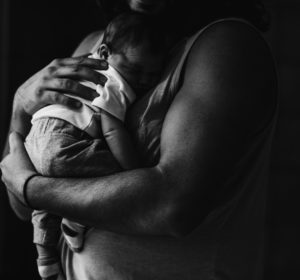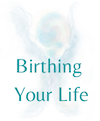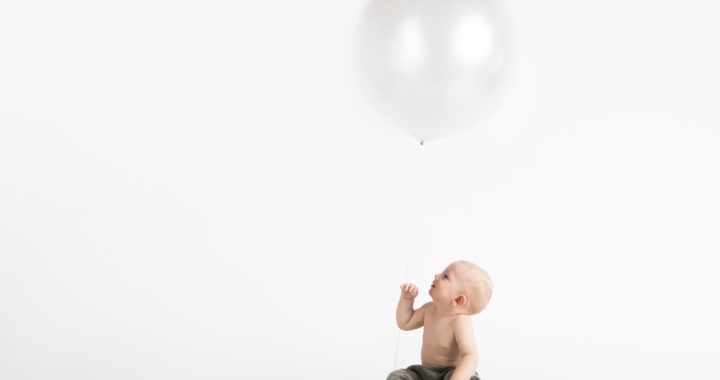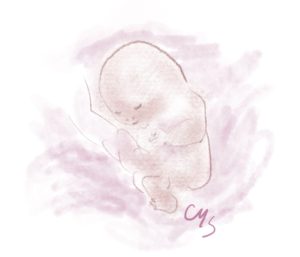As a little embryo or fetus in the womb, you faced many challenges. As you met them, your form changed accordingly. I have learned from spiritual embryologist Jaap van der Wal that we are functional human beings perfectly adapted to our environment from the very beginning. As our conditions change, we also change our form. For example, the protective membrane containing the egg and early embryo begins to dissolve as our need for nourishment increases later in the first week after conception. At this point, we “hatch” out of the zona pellucida and our form looks different.
At that early time of life, our ability to meet developmental challenges determines our survival. For example, if we don’t succeed in implanting in the uterine wall, we die of starvation. Similarly, we must start breathing within moments of being born. The experience of that time can hover through our lives, like a ghost from the past, seeding a tendency to feel like our current challenges are life or death matters. Usually, they are not.
I find it helpful to acknowledge that, no matter how challenging it was back then, I survived. You did, too, if you are reading this.
Back then, our spirit found its way into form, supported by deep universal forces of life. It is still finding its way as we continue to form and re-form, every day, every moment. You are different than you were when you began reading this. Can you feel the difference? In mindfulness practices, breath and sensations are ever-present keys to noting the constant change in our form.
As well as being guided by mysterious life-giving forces, our spirit expresses in human form in response to conditions life presents.
Changing Form as Life Unfolds
This is also true as we meet the uncertainties of this time on the planet. This was brought to my attention the other day as I spoke with someone planning to participate in my upcoming womb surround process workshop. We realised that it had been almost two years since we had previously spoken as she had planned to attend my workshop in March, 2020. As we approached March and a global pandemic was declared, I naively postponed the workshop until June, thinking the worst of the pandemic would be over in the UK by then. The workshop for June, like most other activities involving close contact between people, needed to be cancelled.
At that time, I couldn’t imagine another way to do womb surround workshops. I then began to hear from other womb surround facilitators, including their creator, Ray Castellino, that these workshops could work very well online. In some ways, we find they are even better online! Participants often feel even safer and more resourced in their own homes and the technology seems to support being able to be in an adult state, capable of holding one’s inner little one.
Through meeting this challenge, the womb surround form evolved. This was a developmental edge that I now deeply appreciate. I love working this way!
For many of us, the challenges of this time have felt overwhelming. Just hearing about how others are suffering tears at my heart when I learn about heat waves, fires, and flooding, as well as the inevitable suffering of people escaping, or those not managing to escape, from Afghanistan, terrified of the new regime after years of war. How can these challenges be met?
How can one’s form not be altered by such extreme and potentially traumatizing  experiences? How are your nervous system and related perception affected by political, environmental or climate changes in your own country?
experiences? How are your nervous system and related perception affected by political, environmental or climate changes in your own country?
Supporting a New Form
We are all still coming into form. Holding onto how we were is likely to create more suffering as we resist change. Like people who have lost their homes in fires or floods, the refugees in their new countries will have numerous adjustments to make, like meeting strange languages, food, and other customs. For some, these changes will be overwhelming. I hope the trauma likely in these people will be supported by those who can help.
For me, learning about these extreme challenges reminds me of how fortunate I am. I look around the beautiful garden around our house with appreciation. I see my dear husband eating his breakfast across the room, and I smile. I remind myself of all I can grateful for. The gratitude and appreciation alter my form, helping to balance the formative effects of the daily news.
What supports you in this moment in coming into a form that expresses your spirit? Can you feel yourself continuing to emerge into form? Are you satisfied? What needs to change to enhance your health, your sense of integrity, creativity and aliveness? Under all that, what supports your sense of safety?
We cannot grow and thrive without safety. Even if our environment is not as safe and life-supportive as would be ideal, we can find our way into a form that is ideal for that context. This is something we can learn from the little embryo. Even if implantation was difficult, we found a way to do it.
 Even if we were not as welcomed as we needed back then, we can find ways to welcome ourselves now. As adults, we can even hold and provide safety for the little one within, who may still believe we are not safe.
Even if we were not as welcomed as we needed back then, we can find ways to welcome ourselves now. As adults, we can even hold and provide safety for the little one within, who may still believe we are not safe.
If you consider the little one that you once were, whose experience remains within you, what is your sense of that little one? What might that little being need? Is there a way you can offer that to them? I suggest being curious what happens with your breath, your body, your form, as you have an intention to support the little one within you as the adult that you are.
There is no time like the present to begin forming the next stage of our lives. This moment is the first moment of the rest of your life. What is coming into form for you in this moment? How can you support it?


